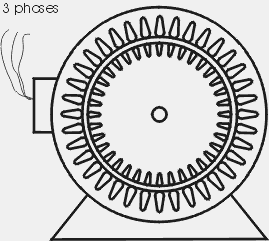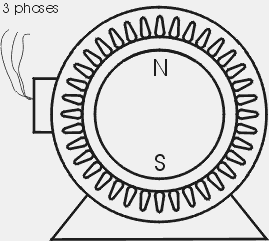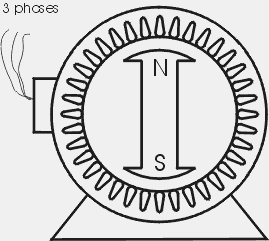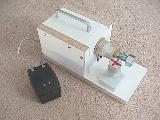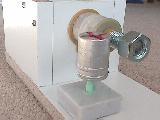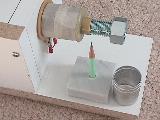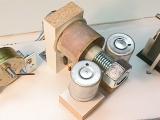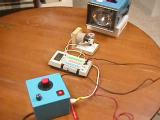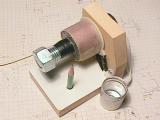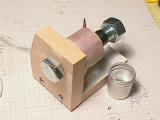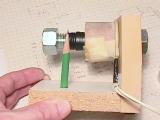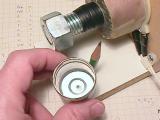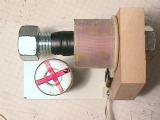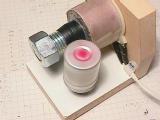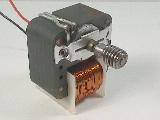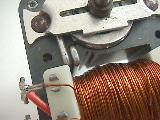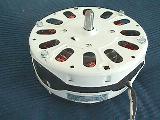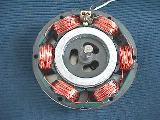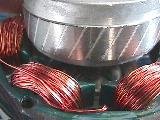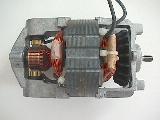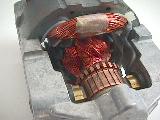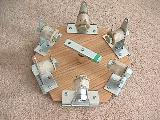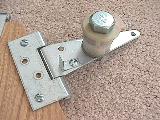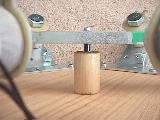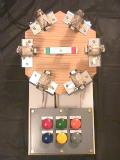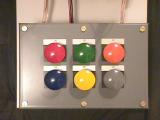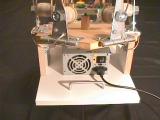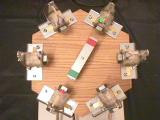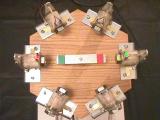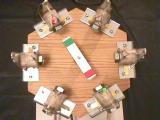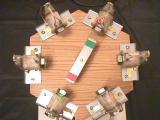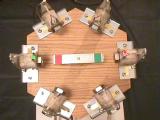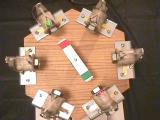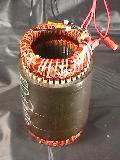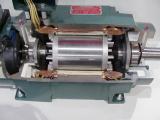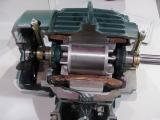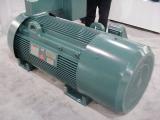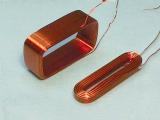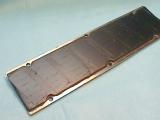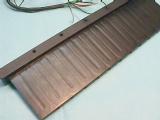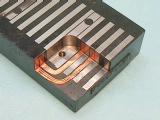· Polyphase Induction Motors One third of the world's electricity consumption is used for running induction motors driving pumps, fans, compressors, elevators and machinery of various types. The AC induction motor is a common form of asynchronous motor whose operation depends on three electromagnetic phenomena:
§ Motor Action - When an iron rod (or other magnetic material) is suspended in a magnetic field so that it is free to rotate, it will align itself with the field. If the magnetic field is moving or rotating, the iron rod will move with the moving field so as to maintain alignment.
§ Rotating Field - A rotating magnetic field can be created from fixed stator poles by driving each pole-pair from a different phase of the alternating current supply.
§ Transformer Action - The current in the rotor windings is induced from the current in the stator windings, avoiding the need for a direct connection from the power source to the rotating windings.
The induction motor can be considered as an AC transformer with a rotating secondary winding.
· Rotating Fields
Rotating magnetic fields are created by polyphase excitation of the stator windings. In the example below of a 3 phase motor, as the current applied to the winding of pole pair A (phase 1) passes its peak and begins to fall, the flux associated with the winding also begins to weaken, but at the same time the current in the winding of the next pole pair B (phase 2) and its associated flux is rising. Simultaneously the current through the winding of the previous pole pair C ( phase 3) and its associated flux will be negative and rising (towards positive). The net effect is that a magnetic flux wave is set up as the flux created by the stator poles rotates from one pole to the next, about the axis of the machine, at the frequency of the applied voltage. In other words, the rotating flux field appears to the stator as the north and south poles of a magnet rotating about the stator.
The magnitude of the rotating flux wave is proportional applied MMF. Ignoring the effect of the back EMF set up by the induced currents in the rotor windings, the flux density Bwill be proportional to the applied voltage.
The stator carries the motor primary windings and is connected to the power source. There are normally no external connections to the rotor which carries the secondary windings. Instead the rotor windings are shorted.
When a current flows in the stator windings a current is induced in the shorted secondary windings by transformer action. The magnitude of the rotor current will be proportional to the flux density B in the air gap (and the relative motion, called the slip, of the rotor with respect to the rotating field as we shall see below). Torque is produced by the reaction between the induced rotor currents and the air-gap flux created by the stator currents.
Many rotor types are used. The most popular AC motors use "squirrel cage" rotors which are constructed from copper or aluminium bars fixed between conducting end rings which provide the short circuit path for the currents induced in the bars.
Since there are no connections to the rotating windings, the costly commutator can be eliminated and with it, a potential source of unreliability.
· Torque Generation (Motor Action)
When the motor is first switched on and the rotor is at rest, a current is induced in the rotor windings (conductors) by transformer action. Another way of seeing this is that the relative motion of the rotating flux passing over the slower moving (initially static) rotor windings causes a current to flow in the windings by generator action. Once current is flowing in the rotor windings, the motor action due to the Lorentz force on the conductors comes into effect. The reaction between the current flowing in the rotor conductors and the magnetic flux in the air gap causes the rotor to rotate in the same direction as the rotating flux as if it was being dragged along by the flux wave.
Similar to the DC machine, the torque in an induction motor T is proportional to the flux density B and the induced rotor current I. Thus
T = k1 BI
Where k1 is a constant depending on the number of stator turns, the number of phases and the configuration of the magnetic circuit.
The rotor speed builds up due to the motor action described above, but as it does so, the relative motion between the rotating stator field and the rotating rotor conductors is reduced. This in turn reduces the generator action and thus the current in the rotor conductors and the torque on the rotor. As the speed of the rotor approaches the speed of the rotating field, known as the synchronous speed, the torque on the rotor drops to zero. Thus the speed of an induction motor can never reach the synchronous speed.
The relative motion between the rotating field and the rotating rotor is called the slip and is given by:
S = Ns- N
Ns
Where S is the slip, Ns is the synchronous speed in RPM, and N is the rotor speed.
Since the rotor current is proportional to the relative motion between the rotating field and the rotor speed, the rotor current and hence the torque are both directly proportional to the slip.
The rotor current is proportional to the rotor resistance. Increasing the rotor resistance will reduce the current and increase the slip; hence a form of speed and torque control is possible with wound rotor motors. Increased rotor resistance also has the added benefit of reducing the input surge current and increasing starting torque on switch on, but all of these benefits are at the expense of more complex rotor designs and unreliable slip rings to give access to the rotor windings.
Synchronous speed in RPM is given by:
Ns = 120 (f)
P
Where f is the powerline frequency in Hz and P is the number of poles per phase. P must be an even integer since for every north pole there is a corresponding south pole.
The following table shows motors speeds for motors with different numbers of poles working with different AC supply frequencies.
| Number of poles | 2 | 4 | 6 | 8 | 10 | 12 |
| Frequency 50 Hz | 3000 | 1500 | 1000 | 750 | 600 | 500 |
| Frequency 60 Hz | 3600 | 1800 | 1200 | 900 | 720 | 600 |
The actual speed of the motor depends on the load it must drive. Increasing the load on the motor causes it to slow down increasing the slip. The motor speed will settle at an equilibrium speed when the motor torque equals the load torque. This occurs when the slip provides just enough current to deliver the required torque.
§ Pole Changing
Early machines were designed with multiple poles to facilitate speed control by pole changing. By switching in different numbers or combinations of poles a limited number of fixed speeds could be obtained.
§ Variable Rotor Resistance
The speed of induction motors can however be varied over a limited range by varying the rotor resistance as noted in the section on slip but only by using wound rotor designs negating many of the advantages of the induction motor.
§ Variable Frequency
Since motor speed depends on the speed of the rotating field, speed control can be effected by changing the frequency of the AC power supplied to the motor.
As in most machines the induction motor is designed to work with the flux density just below the saturation point over most of its operating range to achieve optimum efficiency. The flux density B is given by: B = k2 V
f
Where V is the applied voltage, f is the supply frequency and k2 is a constant depending on the shape and configuration of the stator poles.
In other words if the flux density is constant, the Volts per Hertz is also a constant. This is an important relationship and it has the following consequences.
§ For speed control, the supply voltage must increase in step with the frequency, otherwise the flux in the machine will deviate from the desired optimum operating point. Practical motor controllers based on frequency control must therefore have a means of simultaneously controlling the motor supply voltage. This is known as Volts/Hertz control.
§ Increasing the frequency without increasing the voltage will cause a reduction of the flux in the magnetic circuit thus reducing the motor's output torque. The reduced motor torque will tend to increase the slip with respect to the new supply frequency. This in turn causes a greater current to flow in the stator, increasing the IR volt drop across the windings as well as the I2R copper losses in the windings. The result is a major drop in the motor efficiency. Increasing the frequency still further will ultimately cause the motor to stall.
§ Increasing the voltage without increasing the frequency will cause the material in the magnetic circuit to saturate. Excessive current will flow giving rise to high heat dissipation due to I2R losses in the windings and high eddy current losses in the magnetic circuit and ultimately failure of the motor due to overheating. Increasing the voltage will not force the motor to exceed the synchronous speed because as it approaches the synchronous speed the torque drops to zero.
The variable frequency is normally provided by an inverter. See more about Motor Controls
Note also that since the induced current in the rotor is proportional to the flux density and the flux density in turn is proportional to the line voltage, the torque, which depends on the product of the flux density and the rotor current, is proportional to the square of the line voltage V.
If an induction motor is forced to run at speeds in excess of the synchronous speed, the load torque exceeds the machine torque and the slip is negative, reversing the rotor induced EMF and rotor current. In this situation the machine will act as a generator with energy being returned to the supply.
If the AC supply voltage to the stator excitation is simply removed, no generation is possible because there can be no induced current in the rotor.
§ Regenerative braking
Thus in traction applications, regenerative braking is not possible below synchronous speed in a machine fed with a fixed frequency supply. If however the motor is fed by a variable frequency inverter then regenerative braking is possible by reducing the supply frequency so that the synchronous speed becomes less than the motor speed.
AC motors can be microprocessor controlled to a fine degree and can regenerate current down to almost a stop whereas DC regeneration fades quickly at low speeds.
§ Dynamic Braking
Induction motors can be brought rapidly to a stop (and / or reversed) by reversing one pair of leads which has the effect of reversing the rotating wave. This is known as "plugging". The motor can also be stopped quickly by cutting the AC supply and feeding the stator windings instead with a DC (zero frequency) supply. With both of these methods, energy is not returned to the supply but is dissipated as heat in the motor. These techniques are known as dynamic braking.
Three phase induction motors and some synchronous motors are not self starting but design modifications such as auxiliary or "damper" windings on the rotor are incorporated to overcome this problem.
Usually an induction motor draws 5 to 7 times its rated current during starting before the speed builds up and the current is modified by the back EMF. In wound rotor motors the starting current can be limited by increasing the resistance in series with the rotor windings.
In squirrel cage designs, electronic control systems are used to control the current to prevent damage to the motor or to its power supply. Even with current control the motor can still overheat because, although the current can be limited, the speed build up is slower and the inrush current, though reduced, is maintained for a longer period.
The current drawn by an induction motor has two components, the current in phase with the voltage which governs the power transfer to the load and the inductive component, representing the magnetising current in the magnetic circuit, which lags 90° behind the load current.
The power factor is defined as cosΦ where Φ is the net lag of the current behind the applied voltage due to the in phase and out of phase current components. The net power delivered to the load is VAcosΦ where V is the applied voltage, A is the current which flows.
Various methods of power factor correction are used to reduce the current lag in order to avoid losses due to poor power factor. The simplest is to connect a capacitor of suitable size across the motor terminals. Since the current through a capacitor leads the voltage, the effect of the capacitor is to counter-balance the inductive element in the motor canceling out the current lag.
· Characteristics
One of the major advantages of the induction motor is that it does not need a commutator. Induction motors are therefore simple, robust, reliable, maintenance free and relatively low cost.
They are normally constant speed devices whose speed is proportional to the mains frequency.
Variable speed motors are also possible by using motor controllers which provide a variable frequency output.
· Applications
Three phase induction motors are used wherever the application depends on AC power from the national grid. Because they don't need commutators they are particularly suitable for high power applications.
They are available with power handling capacities ranging from a few Watts to more than 10 MegaWatts.
They are mainly used for heavy industrial applications and for machine tools.
The availability of solid state inverters in recent years means that induction motors can now be run from a DC source. They are now finding use in automotive applications for electric and hybrid electric vehicles. Nevertheless, the induction motor is ill-suited for most automotive applications because of the difficulties associated with extracting heat from the rotor, efficiency problems over wide speed and power ranges, and a more expensive manufacturing process due to distributed windings. Permanent magnetand reluctance motors offer better solutions for these applications.
Wound Rotor Induction Motor Now of historic interest only, these motors were designed to permit control of the speed - torque characteristics of the machine. They used conventional windings on the rotor which were accessible through slip rings. The rotor windings were not connected to the supply line but current through the windings could be controlled by external rheostats connected in series with the windings. Modern electronic controls have made these designs obsolete.
Single Phase Induction Motors
At first sight it might be assumed that it would be impossible to create a rotating field using only a single phase supply. With the aid of an auxiliary stator winding displaced from the main winding it is however possible to create a second MagnetoMotive Force (MMF) in the auxiliary winding, out of phase with the MMF in the main winding, and this is sufficient to generate the rotating field. · Capacitor-Run Motors
The necessary phase difference between the main and auxiliary windings can be provided by connecting a high value capacitor in series with the auxiliary winding. These motors are commonly used in household washing machines, refrigerators and shower pumps and can easily be identified by the large electrolytic capacitor strapped to the motor body.
As an alternative to using an external capacitor, the split-phase method uses a high resistance auxiliary winding. The difference in the impedance of the two windings is sufficient to create the necessary phase difference between the currents in the two windings.
· Shaded Pole Motors
The shaded pole motor uses another, rather crude, method of inducing a second stator MMF, out of phase with the main MMF in order to create the desired rotating field from a single phase AC supply. A short circuited turn of thick copper, known as the shading ring, is mounted in a slot in the pole piece. Some of the magnetic flux produced by the main winding induces a current in the shading ring which produces its own weak flux which opposes and retards the main flux through the ring so that the resulting flux through the ring is out of phase with the main flux. Thus there is a phase difference between one side of the pole and the other. Though inefficient, this method is once more sufficient to set up a rotating field.
§ Characteristics
Single phase induction motors are less efficient than polyphase machines and were developed mainly for domestic use since most dwellings are only supplied with single phase power.
No control of speed.
§ Applications
All kinds of household appliances and light industrial applications.
The synchronous motor is similar to the induction motor in that it is a polyphase machine in which the stator produces a rotating field, however the rotor is constructed from either permanent magnets or electromagnets energised by direct current supplied through slip rings.
· Torque
The torque depends on the attraction of the rotor magnets to the rotating magnetic poles and not on relative motion between the windings in the rotor and the rotating magnetic field. It can therefore lock on to the rotating field. See Alternative Motor Action. Unlike squirrel cage induction motors, synchronous motors can run and produce torque at synchronous speed. They are difficult to start on mains frequency because the rotating field is too fast so they need to start at lower frequency or they need unexcited auxiliary windings or a rudimentary squirrel cage to bring the rotor up to synchronous speed. As the motor approaches synchronous speed it will suddenly snap in to synchronisation.
§ Pull In Torque
To achieve synchronisation the motor torque must be greater then the load torque. The torque developed when the motor locks on to synchronous speed is called the pull in torque. If the load is greater than the pull in torque the motor will not reach synchronous speed.
§ Pull Out Torque
As the load on the motor is increased, the motor torque and the torque angle will also increase. However if the torque angle exceeds 90 degrees the torque will begin to fall and the motor will lose synchronisation and eventually stop. The pull out torque is typically 1.5 times the continuously rated torque.
· Characteristics
Synchronous operation.
· Applications
Fixed speed applications such as clocks and timers
Synchronous Reluctance Motors The so called "synchronous" reluctance motor is designed to run on mains frequency alternating current and it uses distributed stator windings similar to those used in squirrel cage induction motors. The rotor however needs salient poles to create a variable reluctance in the motor's magnetic circuit which depends on the angular position of the rotor. These salient poles can be created by milling axial slots along the length of a squirrel cage rotor. See diagram below.
· Characteristics
The synchronous reluctance motor is not self starting without the squirrel cage. During run up it behaves as an induction motor but as it approaches synchronous speed, the reluctance torque takes over and the motor locks into synchronous speed.
· Applications
Used where regulated speed control is required in applications suc as metering pumps and industrial process equipment.
Hysteresis Motor
The Hysteresis Synchronous motor consists of a wound stator producing a rotating field and a rotor in the form of a cylindrical shell with crossbars all made from hard steel with relatively high magnetic hysteresis.
At start up, the combined effects of eddy currents in the steel causing induction motor action and remanent magnetism in the steel causing the magnetic poles to follow the rotating field, together cause the motor speed to build up. As the motor approaches synchronous speed the magnetic effect of the crossbars behaving like a permanent magnet causes the motor to lock on to synchronous speed. The net result is that the torque is roughly constant at all speeds.
· Characteristics
Simple design
Starts as an induction motor and locks in as a synchronous motor.
Having a smooth rotor of homogenous material, the noise and vibration produced is inherently low. Since there are no pole faces or saliencies, the magnetic path is of constant permeability, thus eliminating the magnetic pulsations which are the major cause of noise in the salient pole type.
· Applications
Their efficiency is low, and applications are restricted to small power ratings.
Used extensively in tape recorders and clocks.
Now mostly replaced by permanent magnet motors.
An AC motor which uses separately excited rotor windings using a commutator to feed current to rotor coils behaves in much the same way as a brushed DC motor and can in fact be used as a universal motor taking its supply either from an AC or a DC source.
Unlike induction and synchronous motors, the speed of universal motors is not limited by the electric mains supply frequency and can easily exceed one revolution per cycle. This makes them useful for household appliances such as blenders, vacuum cleaners and hair dryers which need high-speed operation. Speeds of up to 30,000 RPM are possible but the current carrying capacity is limited by the commutator and brushes which restricts their use to low power applications of about 1 kilowatt or less






